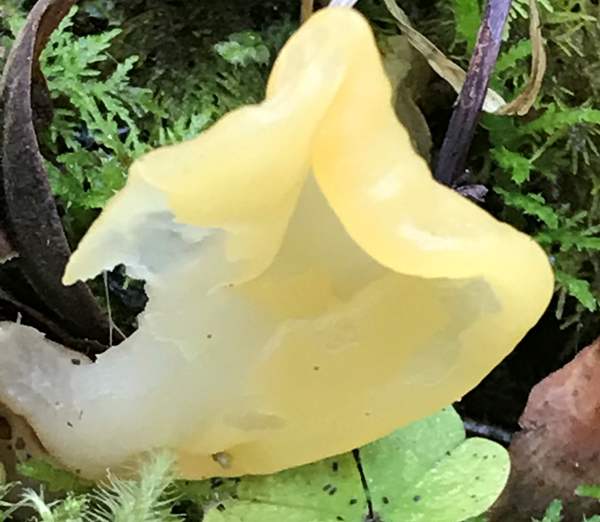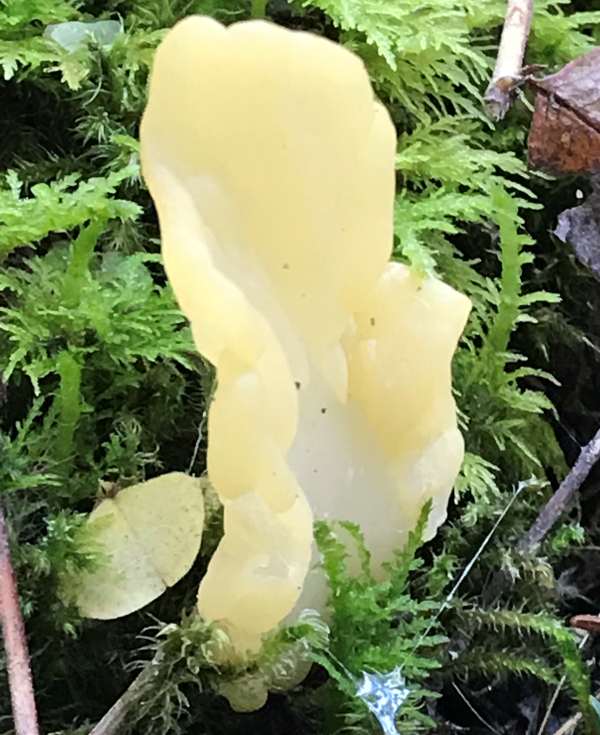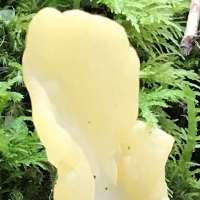Trees Birds Mammals Fish Amphibians Reptiles
Wild Algarve
Bookshop
Spathularia flavida Pers. - Yellow Fan
Phylum: Ascomycota - Class: Leotiomycetes - Order: Helotiales - Family: Cudoniaceae
Distribution - Taxonomic History - Etymology - Identification - Reference Sources

In Britain and Ireland this rare ascomycetous fungus is generally known as Yellow Fan; other common names include Yellow Fairy Fan and Yellow Earthtongue.
The role of these little club-like fungi in the natural world is thought to be that of recycler; they feed of fallen conifer needles and rotting twigs, helping to break them down into simple compounds that trees and other plants can feed on.

Distribution
A rare find in Britain and Ireland, Yellow Fan also occurs in parts of mainland Europe as well as in Asia and North America.
Taxonomic history
The great South-African born mycologist Christiaan Hendrick Persoon described this ascomycetous fungus in 1794, he named it Spathularia flavida. To the present day that remains the generally accepted scientific name for Yellow Fan; however, in the past other mycologists describing this species gave it many other scientific names.
Synonyms of Spathularia flavida Pers. include Clavaria flavida (Pers.) Mussat, Helvella clavata Schaeff., Spathularia clavata (Schaeff.) Sacc., Clavaria spatulata Dicks., Helvella spatulata (Dicks.) Purton, Mitrula crispata Fr., Spathulea crispata (Fr.) Fr., Spathularia crispata (Fr.) Mussat, and Mitrula spathulata Fr.
Etymology
The genus name Spathularia refers to the spatula-like shape - a short-handled implement with a broad, flat, blunt blade used for spreading paste etc (for example in cookery), while the specific epithet flavida means yellow.
Identification guide
 |
Cap
The fan-shaped or spoon-shaped fruitbody has a wavy or lobed cream or yellow head upon a white or cream stem. Overall height is 2-8 cm of which the fertile head is typically 60%. The round- or oval-sectioned smooth stem is typicaly 1cm across and paler than the head. |
|
Asci
Typically 85-125 x 8-12µm, inamyloid; eight spores per ascus stored side by side.
Paraphyses
Slender, forked, spirally curled at the tips.
|
| |
Spores
Needle-shaped, smooth, multi-septate when mature; typica;ly 30-60 x 1.5-3µm; hyaline.
Spore print
White or very pale buff. |
Odour/taste |
Not distinctive. |
Habitat & Ecological role |
Saprobic, often gregarious or in fairy rings, on needle litter in coniferous woodland. |
Season |
Most often seen in Britain in late summer and autumn. |
Similar species |
Other similar Spathularia species are distinguished by the colour or surface texture of the stem. |
Reference Sources
Fascinated by Fungi, 2nd Edition, Pat O'Reilly 2016, reprinted by Coch-y-bonddu Books in 2022.
Dennis, R.W.G. (1981). British Ascomycetes; Lubrecht & Cramer; ISBN: 3768205525.
Breitenbach, J. & Kränzlin, F. (1984). Fungi of Switzerland. Volume 1: Ascomycetes. Verlag Mykologia: Luzern, Switzerland.
Medardi, G. (2006). Ascomiceti d'Italia. Centro Studi Micologici: Trento.
British Mycological Society. English Names for Fungi
Dictionary of the Fungi; Paul M. Kirk, Paul F. Cannon, David W. Minter and J. A. Stalpers; CABI, 2008
Taxonomic history and synonym information on these pages is drawn from many sources but in particular from the British Mycological Society's GB Checklist of Fungi.
Acknowledgements
This page includes pictures kindly contributed by Carol Lines.
Top of page...
Fascinated by Fungi. Back by popular demand, Pat O'Reilly's best-selling 450-page hardback book is available now. The latest second edition was republished with a sparkling new cover design in September 2022 by Coch-y-Bonddu Books. Full details and copies are available from the publisher's online bookshop...